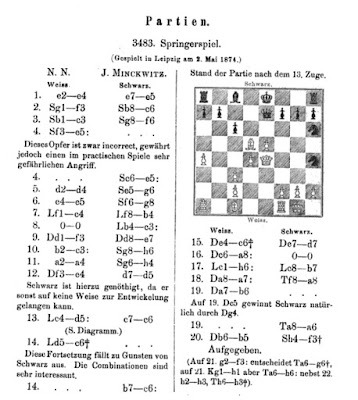Although Krabbe goes back as far as Oskar Cordel, Führer durch die Schachtheorie: Ausführliche Tabelle der Spiel-Eröffnungen auf Grundlage neuester Forschung (1888), there were at least two games published in magazines prior to Cordel's text. Cordel notes that the opening had been played in Leipzig and a game played there in 1874 is the oldest in ChessBase Mega 2024.
The annotation in Deutsche Schachzeitung (July 1874) of the game between an unnamed player who played the gambit against Johannes Minckwitz, editor of the publication, offers what remains today an apt assessment of the gambit: it is unsound, but in practical play White gets a dangerous attack.
I offer the original annotations, which were in German, translations, and some of my own comments.
NN -- Minckwitz,Johannes [C47]
Leipzig, 02.05.1874
1.e4 e5 2.Nf3 Nc6 3.Nc3 Nf6 4.Nxe5
Dieses Opfer ist zwar incorrect, gewährt jedoch einen im practischen Spiele sehr gefährlichen Angriff. This sacrifice is indeed incorrect, but grants a very dangerous attack in the practical game.
4...Nxe5 5.d4
Leipzig, 02.05.1874
1.e4 e5 2.Nf3 Nc6 3.Nc3 Nf6 4.Nxe5
Dieses Opfer ist zwar incorrect, gewährt jedoch einen im practischen Spiele sehr gefährlichen Angriff. This sacrifice is indeed incorrect, but grants a very dangerous attack in the practical game.
4...Nxe5 5.d4
Black to move
5...Ng6
5...Nc6 is the principal alternative.
6.e5 Ng8 7.Bc4 Bb4 8.0–0 Bxc3 9.Qf3 Qe7 10.bxc3 Nh6 11.a4 Nh4 12.Qe4
5...Nc6 is the principal alternative.
6.e5 Ng8 7.Bc4 Bb4 8.0–0 Bxc3 9.Qf3 Qe7 10.bxc3 Nh6 11.a4 Nh4 12.Qe4
Black to move
12... d5
Schwarz ist hierzu genöthigt, da er sonst auf keine Weise zur Entwickelung gelangen kann.
Black is compelled to do this, because otherwise he cannot achieve development in any way.
13.Bxd5 c6 14.Bxc6+!
Diese Fortsetzung fällt zu Gunsten von Schwarz aus. Die Combinationen sind sehr interessant.
Schwarz ist hierzu genöthigt, da er sonst auf keine Weise zur Entwickelung gelangen kann.
Black is compelled to do this, because otherwise he cannot achieve development in any way.
13.Bxd5 c6 14.Bxc6+!
Diese Fortsetzung fällt zu Gunsten von Schwarz aus. Die Combinationen sind sehr interessant.
This sequel is in Black's favor. The combinations are very interesting.
14...bxc6 15.Qxc6+ Qd7 16.Qxa8 0–0
14...bxc6 15.Qxc6+ Qd7 16.Qxa8 0–0
White to move
17.Bxh6
This move gives Black opportunities. Better would be 17.Ba3 or 17.Rb1.
17...Bb7 18.Qxa7 Ra8 19.Qb6
19.Qc5 Qg4
19...Ra6?
This move gives Black opportunities. Better would be 17.Ba3 or 17.Rb1.
17...Bb7 18.Qxa7 Ra8 19.Qb6
19.Qc5 Qg4
19...Ra6?
White to move
20.Qb5??
20.e6!! Qd5 21.exf7+ Kf8 22.Qb4+ Kxf7 23.f3 and White should prevail. The move played walks into a mate in four, which Minckwitz finds.
20...Nf3+ 0-1
21.gxf3 Rg6+
21.Kh1 Rxh6 22.h3 Rxh3+
Ten years later, the second game in the database was played and published. It was part of a blindfold exhibition in St. Petersburg. Ernst Falkbeer provided annotations.
20.e6!! Qd5 21.exf7+ Kf8 22.Qb4+ Kxf7 23.f3 and White should prevail. The move played walks into a mate in four, which Minckwitz finds.
20...Nf3+ 0-1
21.gxf3 Rg6+
21.Kh1 Rxh6 22.h3 Rxh3+
Ten years later, the second game in the database was played and published. It was part of a blindfold exhibition in St. Petersburg. Ernst Falkbeer provided annotations.
The White player is not well-known. Sarah Cohen (aka batgirl) described him as a strong amateur in "The Prince of Mingrelia, Part 1" on chess.com. The game was published in a Vienna newspaper: Wiener Hausfrauen-Zeitung (1885), which I was able to find online.
De Marcovan,M - NN [C47]
Blindfold Exhibition M de Marcovan St Petersburg, 1884
[Falkbeer,Ernst Karl]
1.e4 e5 2.Nf3 Nc6 3.Nc3 Nf6 4.Nxe5
Ein ganz neues und geniales Opfer des Blindspielers, um die Partie interessanter zu machen.
De Marcovan,M - NN [C47]
Blindfold Exhibition M de Marcovan St Petersburg, 1884
[Falkbeer,Ernst Karl]
1.e4 e5 2.Nf3 Nc6 3.Nc3 Nf6 4.Nxe5
Ein ganz neues und geniales Opfer des Blindspielers, um die Partie interessanter zu machen.
A completely new and ingenious sacrifice of the blind player to make the game more interesting.
4...Nxe5 5.d4 Ng6 6.e5 Ng8 7.Bd3 d6 8.f4 dxe5 9.fxe5
4...Nxe5 5.d4 Ng6 6.e5 Ng8 7.Bd3 d6 8.f4 dxe5 9.fxe5
Black to move
9...Bb4
Augenscheinlich darf die Dame den Bauer auf d4 nicht schlagen, weil sie sonst durch 9...Qxd4 10.Bb5+ verloren ginge.
Augenscheinlich darf die Dame den Bauer auf d4 nicht schlagen, weil sie sonst durch 9...Qxd4 10.Bb5+ verloren ginge.
Apparently, the queen must not capture the pawn on d4, otherwise she will pass through (discovered attack) 9...Qxd4 10.Bb5+ was lost.
10.0–0! Qxd4+ 11.Kh1 Bxc3 12.bxc3
10.0–0! Qxd4+ 11.Kh1 Bxc3 12.bxc3
Black to move
12...Qxc3
Schwarz hätte den Bauer auf c3 nicht schlagen, sondern die Dame nach 12...Qd8 zurückziehen sollen.
Schwarz hätte den Bauer auf c3 nicht schlagen, sondern die Dame nach 12...Qd8 zurückziehen sollen.
Black should not have captured the pawn on c3, but should have withdraw the queen with 12...Qd8.
13.Qf3
Ausgezeichnet gespielt. Weiß droht jetzt zu gleicher Zeit das direkte Schach auf f7 und das Abzugsschach, respektive den Gewinn der Dame durch 14.Lb5+.
13.Qf3
Ausgezeichnet gespielt. Weiß droht jetzt zu gleicher Zeit das direkte Schach auf f7 und das Abzugsschach, respektive den Gewinn der Dame durch 14.Lb5+.
Excellently played. White is now threatening direct check on f7, or winning the queen by 14.Bb5+.
13...Qxe5
Es war schon gar nichts mehr zu machen.
13...Qxe5
Es war schon gar nichts mehr zu machen.
There was nothing more to be done.
Wenn die Dame den Turm nahm, so folgte 13...Qxa1 14.Qxf7+ Kd8 und dann 15.Bg5+
Wenn die Dame den Turm nahm, so folgte 13...Qxa1 14.Qxf7+ Kd8 und dann 15.Bg5+
If the queen took the rook, then 13...Qxa1 14.Qxf7+ Kd8 and then Bg5+.
14.Qxf7+ Kd8 15.Bxg6 hxg6
14.Qxf7+ Kd8 15.Bxg6 hxg6
White to move
16.Bg5+
Ein schönes Endspiel dieser reizenden kleinen Partie.
Ein schönes Endspiel dieser reizenden kleinen Partie.
A beautiful endgame of this charming little game.
16...Ne7 17.Rad1+ Bd7
Weiß setzt in zwei Zügen matt:
16...Ne7 17.Rad1+ Bd7
Weiß setzt in zwei Zügen matt:
White mates in two moves:
18.Qf8+ Rxf8 19.Rxf8# 1-0
18.Qf8+ Rxf8 19.Rxf8# 1-0























No comments:
Post a Comment